While the mobile Diablo Immortal may not be as eagerly anticipated as Diablo 4, fans are starting to get their hands on the smartphone adaptation of Blizzard’s classic dark action RPG via closed alpha tests. TechRadar got access to the latest alpha – and I’m sharing my first thoughts on how the game plays on small screens.
With the usual caveat that a lot can change between this alpha version and the final product (which still doesn’t have a release date), Diablo Immortal is already shaping up to be a fairly faithful adaptation of the classic Diablo gameplay.
Of course, without a mouse and keyboard, Diablo Immortal makes some compromises to work with on-screen touch controls. But the overall gameplay loop should feel familiar: players embody one of a powerful yet diverse roster of hero classes as they purge the game’s world Sanctuary of monsters in a variety of fun environments.
Diablo Immortal inherits a lot from Diablo 3, including destructible environments, several classes (think Crusader or Demon Hunter), and the endgame procedurally-generated Rift dungeons. While Immortal’s stages and enemies are vibrantly colored, the developers seem to have kept their word in dialing down the tone to a dimmer, bleaker standard set by Diablo 2.
It’s fairer to say the game has more of Diablo 3’s empowering, arcade-like action feel than Diablo 2’s murky clickfest dungeon delving, but veteran Diablo fans should still get a thrill out of lining up enemies and blowing them away with powerful (and familiar) abilities. Given Diablo Immortal is set between the second and third games, it’s hard not to feel like this is a greatest hits version of the Diablo experience that shaves off plenty of complexity, but in exchange you get a Diablo you can take anywhere – and even some new MMO-like multiplayer modes teased at BlizzCon 2021.
One final note: while this current closed Alpha is mainly for Australian users running Android phones, TechRadar was invited to play in the US on iOS (we used an iPhone 12 Pro). Let’s dive into the meat of Diablo’s mobile game so far.
Classes so far...and the new Crusader
Diablo Immortal has had very limited closed alpha tests before, and developers have only allowed access to a few areas and classes. While four classes have been playable before – Barbarian, Monk, Demon Hunter, and Wizard – this is the first time players can choose the Crusader class (leaving Necromancer as the last to be revealed). All are more or less similar to their versions from the main games, though their signature abilities have been adapted for smartphone touchscreen controls.
Crusader was added in the Diablo 3: Reaper of Souls DLC, and the core of the class – a shield-toting armored melee combatant with various area of effect (AOE) damage auras and abilities – has been preserved in Diablo Immortal. It appears that players in this Alpha can reach level 50 and unlock a bevy of skills (we reached level 35 at time of writing, unlocking a little over half of the ability arsenal).
As we discuss more in detail below, the controls are simplified such that attacks auto-target the nearest enemy or whichever foe you’re moving toward, which is a crude yet effective enough way to get a modicum of precision in a game so tuned to churning through masses of enemies. Tapping and holding ability buttons projects a highlighted pathway from the player character’s feet, allowing players a bit of aim. And don’t worry about mana – every ability in the game simply works off cooldown.
Much like they were in Diablo 3, the Crusader is a tanky melee class with damaging abilities mostly centered around the player – the first one they start with, Sweep Attack, is a hemispherical arc that gets bigger as the player holds down the ability button (and the Crusader winds up their magical flail for a wider swing).
Other signature abilities return, like Falling Sword (toss a sword into the ground for small AOE damage, tap again to teleport to the sword) and Draw and Quarter is a reworked version of Steed’s Charge from Diablo 3 that chains nearby enemies to drag behind the player while they slash on either side.
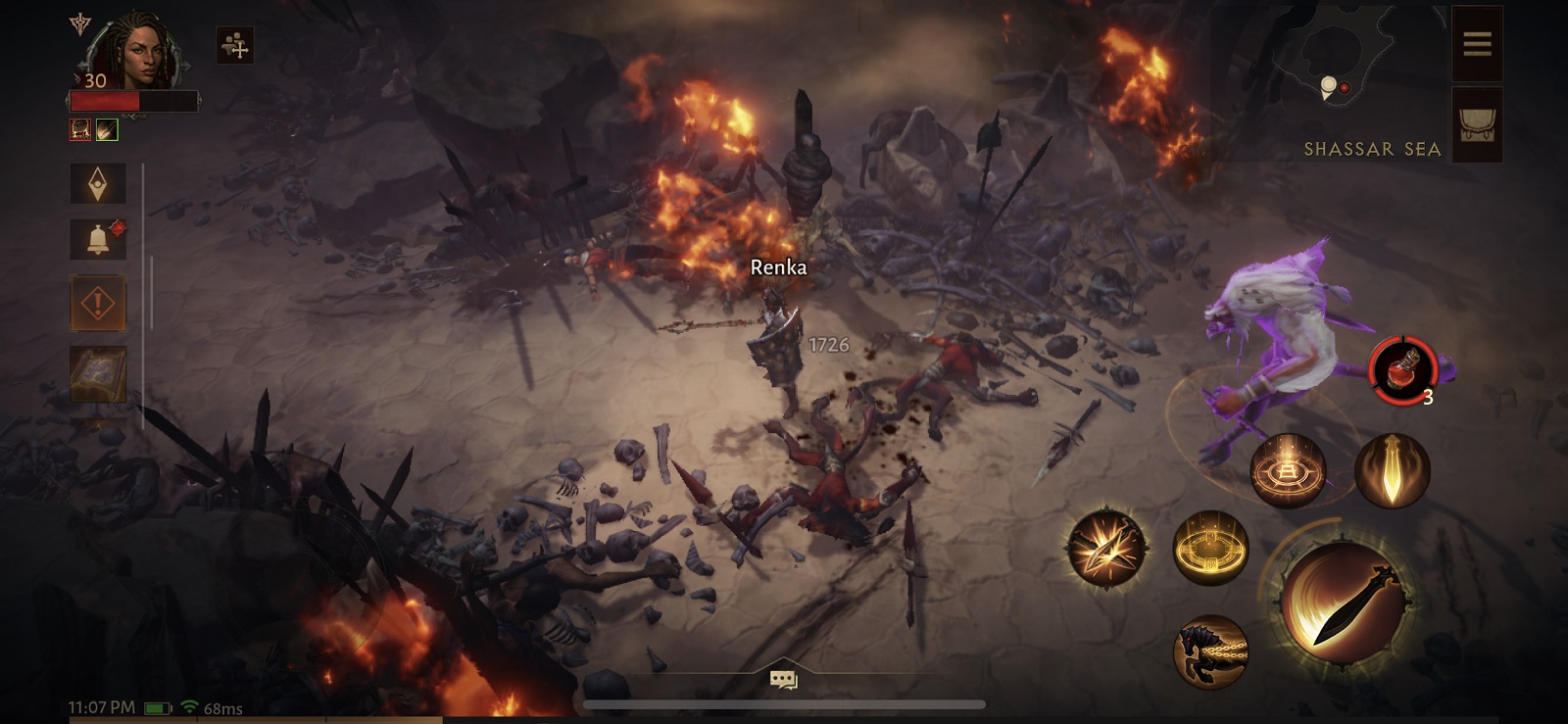
There is something new to Diablo Immortal, which you'll notice in the screenshot above: an ultimate ability, which is tuned to which basic attack you've selected and amplifies its perks for a limited time. You can see it in the screenshot above as the button to the left of the initial four-button tier.
In short, veteran Diablo players will find plenty of similarities in the Diablo Immortal classes, which offer streamlined and simplified versions of their console counterparts.
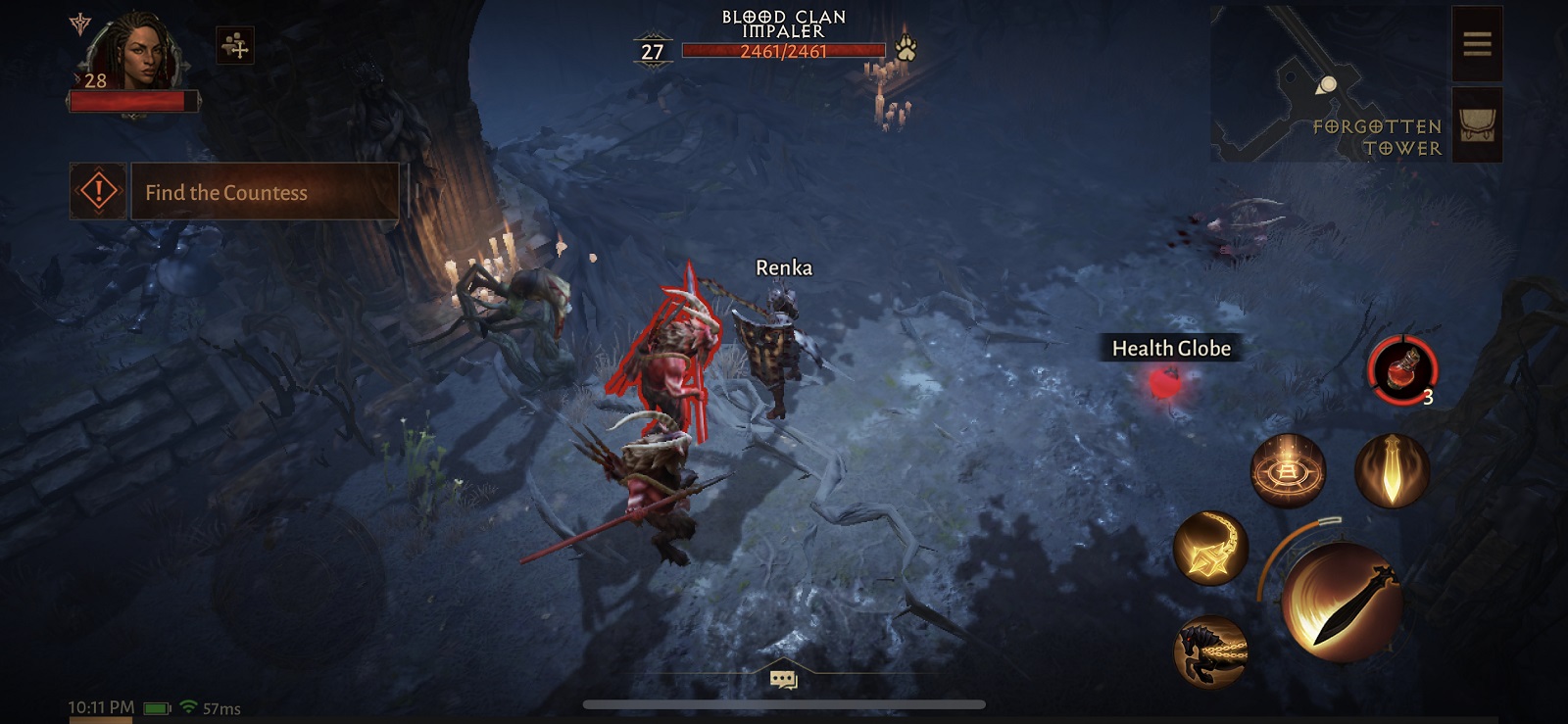
Controlling Diablo on a smartphone
The controls are simplified from the classic desktop Diablo games, though they’ll feel a bit more familiar to folks who have played the console versions of Diablo 3 with their own controller-adapted commands. In other words: it’s exact enough, and fits the player-vs-many enemies focus of the game’s action.
To be specific, the Diablo Immortal button layout looks a lot like those on League of Legends: Wild Rift and other smartphone MOBA games: a floating directional pad on the left, a big attack button on the right and smaller ability buttons fanned around it. If an ability calls for directional control, you’ll be able to hold the respective button down to aim a highlighted arrow (or cone or lane or whatever shape the ability takes) and let go to let fly.
These touch controls are obviously less precise than a mouse and keyboard, and it’s not clear at first that there really isn’t a way to target individual enemies. In some ways, you don’t need to, as your abilities are all are of effect (AOE), at least as far as we’ve found. Your basic attacks auto-target the closest enemy, and abilities default to the auto-targeted enemy. Imprecise, but given players are generally encountering big groups of monsters, you won’t really need precision.
You also won’t need to worry about mana: abilities are just on cooldown, typically taking 8-12 seconds to reset. This dramatically simplifies the action loop and keeps the focus on combat rather than worrying about running out of ability juice mid-fight, though some players may miss balancing their resource pool (or pools, in the case of Demon Hunter).
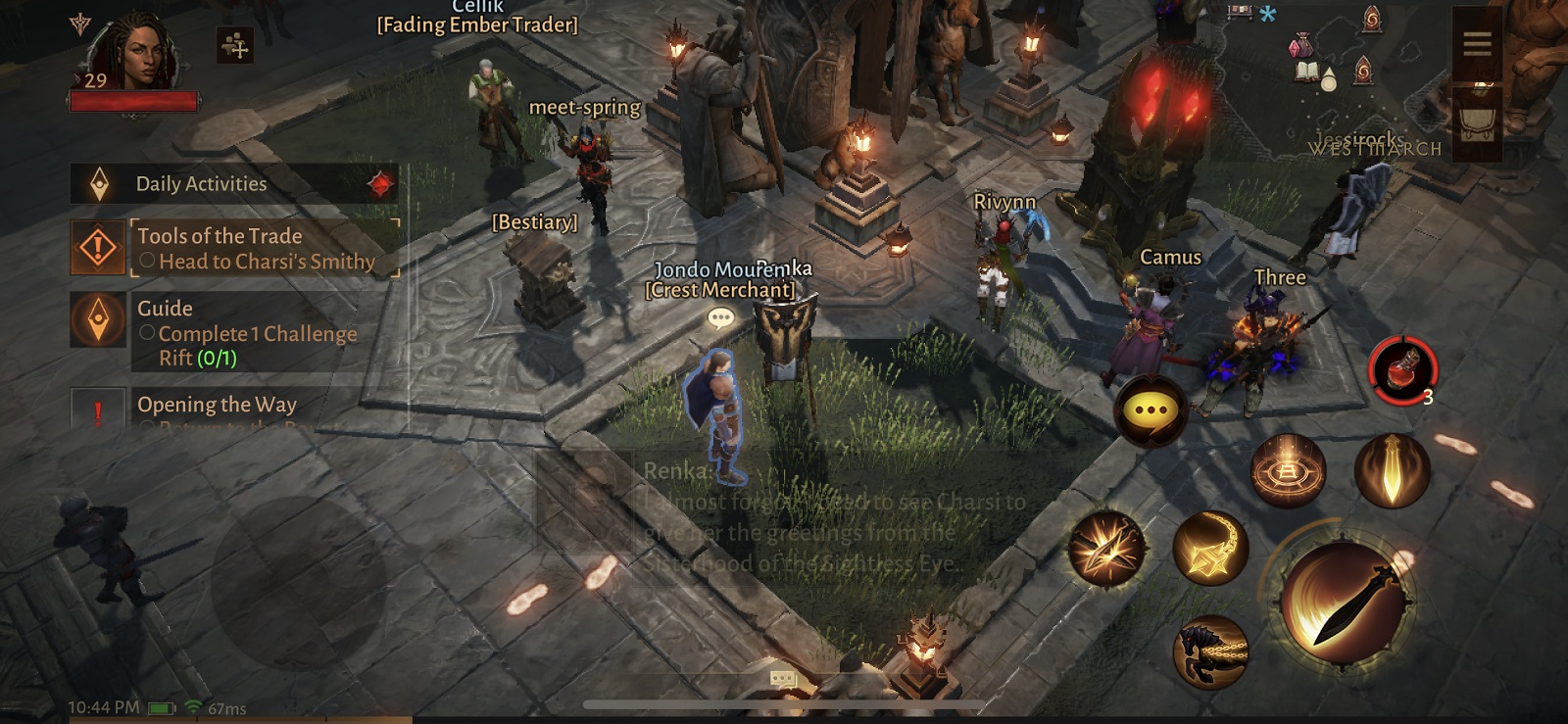
Admittedly, the screen is small, and can get cluttered with buttons, names, loot, and vendors, though mostly while in town (see screenshot above) – I rarely lost track of my character in the middle of clumps of enemies while in combat.
The Diablo Immortal team has added touches to make action pop on the small screen. There’s a tangibility to hitting enemies -- classes like the Crusader wielding big weapons have a crunchy screen-shake when striking foes with basic attacks. Most of the audio cues feel imported wholesale from Diablo 3, so expect the same zaps from Wizard beams and crunches from Crusader and Barbarian epic blows.
There’s drawbacks to such a small screen, and things Blizzard may need to work out through the next test versions. In particular, the quest log on the left side extends downward, adding new tasks that block the directional area. Sometimes I’d encounter tough champion enemies and find myself not moving because the quest log had blocked the screen area for me to direct my character outta there.
You can swipe the quest log away (which itself is a bit tough to toggle), but it’s by far the biggest control hiccup. I also occasionally tapped an ability when I meant to hit attack, but given the short cooldowns for skills, it wasn’t too annoying a mistake.
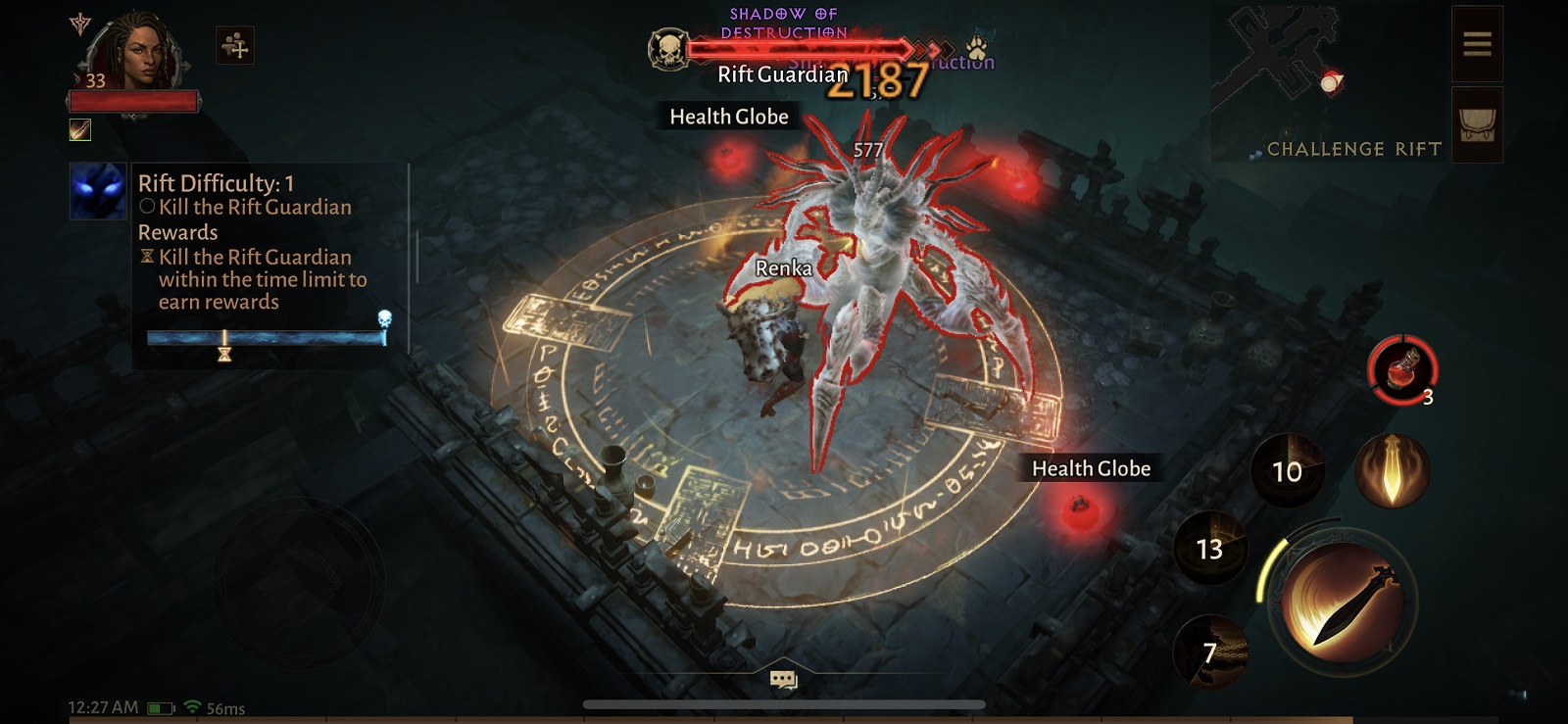
So how Diablo-ish is Diablo Immortal?
After playing around 10 hours of the Alpha and reaching level 35, having run through three of the game’s areas via story quests, I can safely say that a lot of the Diablo experience has been adeptly preserved in the mobile game, even this early in Alpha testing. If you like cruising through big groups of enemies, flinging abilities hither and yon to crush masses of foes, you’ll get a kick out of Diablo Immortal, and the repeatable gameplay loop may surprisingly hook you.
That description may be telling: the game adheres to more of the arcade gameplay of Diablo 3 rather than the more grounded hack-and-slash combat of Diablo 2. And regardless of how much the devs say they’ve invoked the grim, dark dungeon-ey look of the latter in Diablo Immortal’s design, it’s the brighter and more vibrant look of Diablo 3 that has the most influence. (But look out for some familiar faces from the fan-favorite Diablo 2: I was cheered to encounter a randomly-generated Rift dungeon full of the mask-wearing tiny fetish enemies I dearly remembered from that game.)
Indeed, Diablo Immortal feels like a Greatest Hits album for Diablo, preserving a lot of the enemies and encounters from the series in a more streamlined experience. Fittingly, the game is set between Diablo 2 and 3, allowing character who (spoiler alert) bit the dust in the latter to appear in Diablo Immortal, like everyone’s favorite loremonger, Deckard Cain, and the cantankerous Vizjerei spirit Zoltan Kulle.
Diablo Immortal even has flourishes uniquely its own, like environmental animations and massive multi-part boss battles that make for a more dynamic experience than we saw in Diablo 3. Here’s an example of a mid-game dungeon that spotlights this:
And there are improvements that dramatically improve quality of life, though they’re arguably also made to streamline the mobile experience. For instance, equipping new items will let you swap any socketed gems (as well as transfer rank upgrades) to the new one without a fee or fuss, which makes it a lot easier to swap in new equipment in the middle of a dungeon. Likewise, you can auto-navigate to the next step in a quest by tapping it in your on-screen quest log, after which you’ll warp to the closest spot and auto-walk to it. Easy.
Other streamlining is less obvious: classes only have one weapon type that you essentially just replace through the game. Crusaders, for instance, have a one-handed weapon slot (sword, mace, hammer, etc) and a shield; they can’t equip two-handed weapons or anything ranged. Socketed items can only insert gems, and even though runes have returned, they’re only used to buy fancy legendary gems, not socket in sequence to form the powerful runewords from Diablo 2.
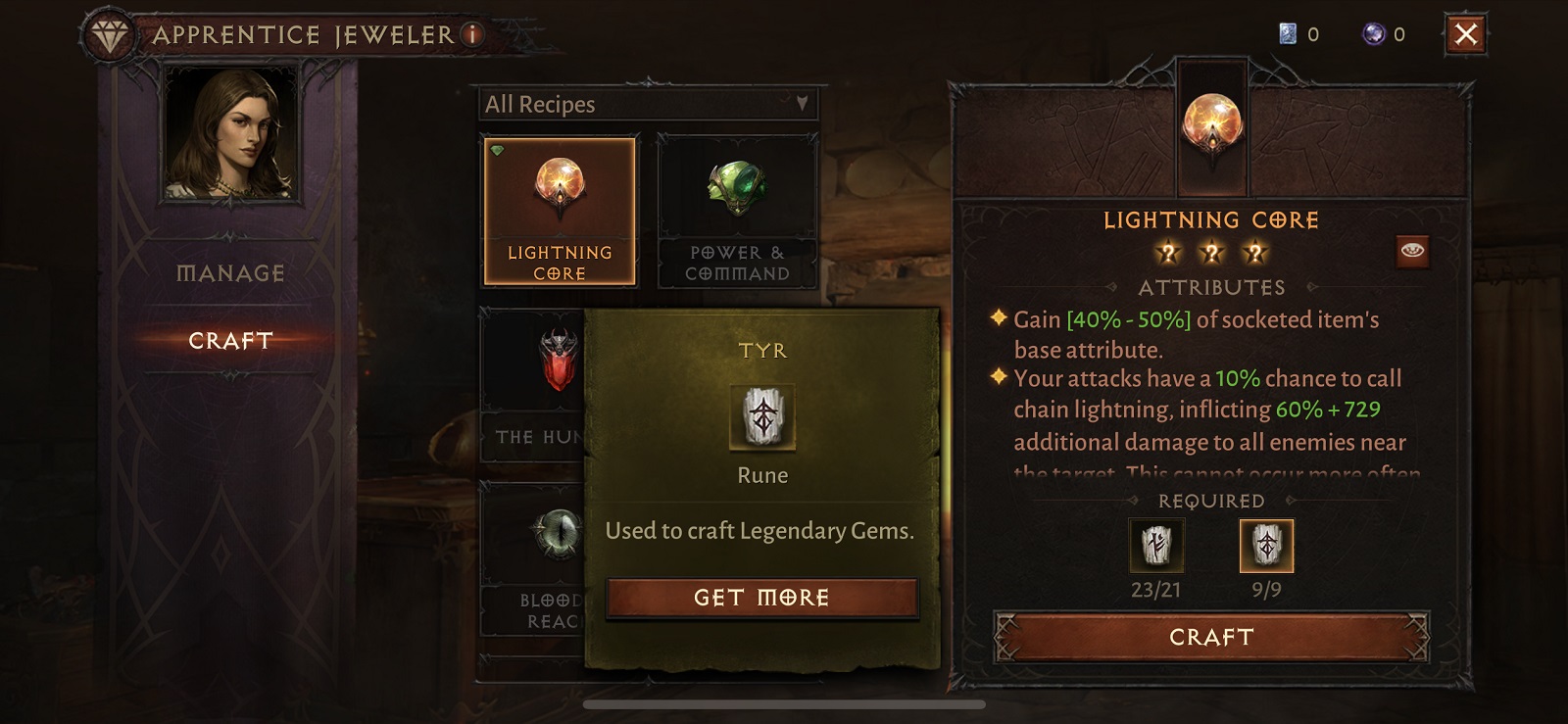
Some of the compromises are even welcome: the areas outside town are a lot smaller, and you won’t be wandering in the wilderness hoping you’re headed in the right direction thanks to helpful glowing footprints pointing the way. That might be too much hand-holding for some players, but at the small scale of smartphones, it’s fine.
Players will probably spend most of their time in Rifts anyway: the procedurally-generated dungeon instances return in two varieties, Elder and Champion. The former you can juice up with insertable Crests, while the latter simply increase in difficulty by number.
Crests are just the tip of the iceberg, with a slew of in-game currencies and collectible tokens to spend on boosting Rifts, buying gems, upgrading equipment, and yes, a special kind of experience points for the battle pass.
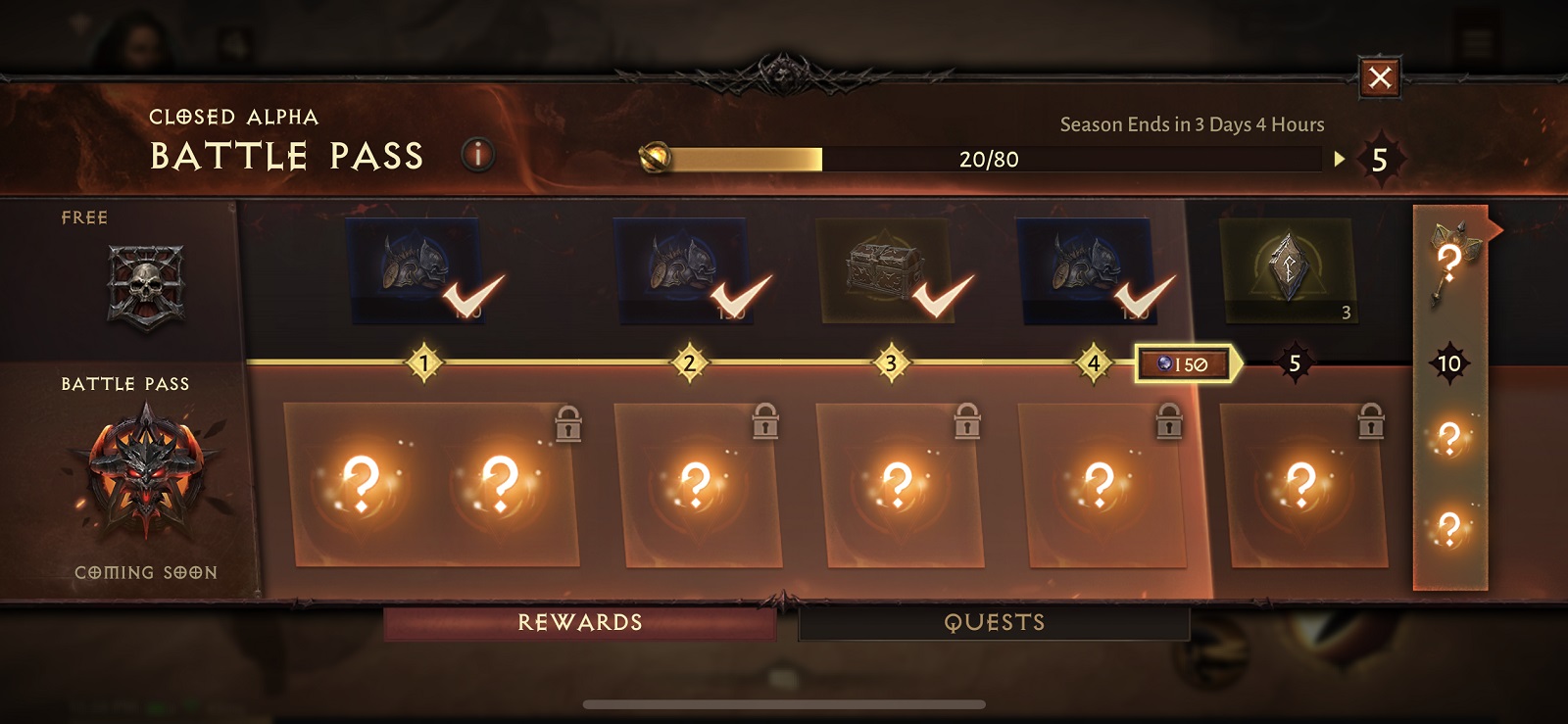
Even in this early Alpha, the Diablo Immortal team has implemented a battle pass with free and paid tiers, which offer materials and items. While the paid tier isn’t accessible, the groundwork is there, and players will likely also have the option to pay real money for an in-game currency to juice up their Rifts.
Lastly, while Rifts are ideal for the PvE fans, there’s a few additional activities that get at the MMO-like multiplayer interactivity that the Diablo Immortal team teased at BlizzCon 2021: Battleground, an 8v8 casual player vs. player (PvP) mode pitting teams against each other as they escort Zealous Idols to destroy opponents' nexus-like Ancient Heart, and a new faction-based PvP system called Cycle of Strife. The latter is very involved, splitting players between top-performing Immortals and the rest of the players clawing their way up the ranks as Shadows:
Wage war for the Eternal Crown in #DiabloImmortal's new faction-based PvP system: Cycle of Strife.Uphold duty as an Immortal or keenly watch as a Shadow, ready to take the Immortals down if they prove unworthy of their station. pic.twitter.com/BtyqgDoe6EApril 26, 2021
The system itself, as outlined in an official blog post, is a bit complicated as it's currently established in the closed Alpha – put simply, the teams of Shadows compete for the top slot, and that best team gets temporary windows every week to challenge the current top-ranked players, called Immortals. If the former win, they become the new top dogs, and the cycle begins anew.
Why go through all the trouble? The Immortal leader bears the Eternal Crown, and they can deign four friends to become Lieutenants with their own lesser but still powerful crowns, all of which gain powers. Immortals also have access to Kion's Ordeal, a 48-player raid with four bosses which must be defeated within 30 minutes. Beating it grants powerful loot along with a buff providing a bonus to Elder Rifts.
Given this system is the newest addition to Diablo Immortal and debuted first in this Alpha, we’ll update this story when we finally get access and we hear more about the game’s full release.
- Stay on top of tech news with the TechRadar newsletter
from TechRadar - All the latest technology news https://ift.tt/32YLi3q
No comments:
Post a Comment